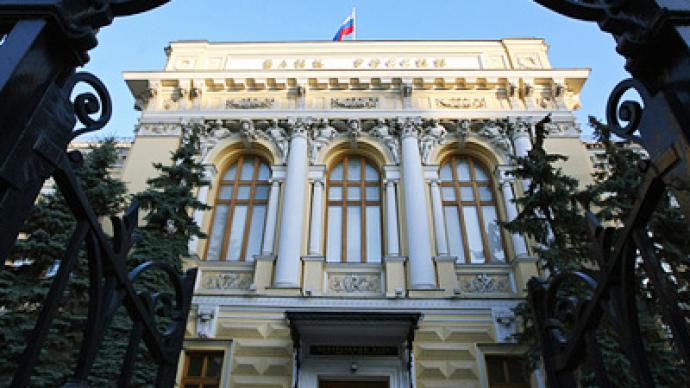Russian banking holds up, but challenges remain

With the Russian banking system coming through the financial crisis and economic downturn better than had been expected in many quarters, Business RT spoke with Richard Hainsworth, CEO of independent Russian ratings specialist RusRating.
RT:Concerns about the liquidity of the Russian banking system have continued to ease through 2010, to the point where deposits are probably greater then some banks would want.How significant has been the slow growth in lending?RH: “RusRating has consistently argued throughout the crisis that the concerns about the Russian banking system raised by foreign analysts have been exaggerated. Whilst a global credit and liquidity crisis must have an impact on the Russian banking system and the Russian economy, and this can definitely be seen, the Russian banking system as a whole was much better prepared to meet the crisis than most 'outsiders' and some 'insiders' had anticipated.The liquidity of the banks was threatened when the financial instruments (primarily Russian traded securities) used by banks to store liquidity lost all value during the crisis. General liquidity was restored to the market by the Central Bank and the Ministry of Finance during the crisis by massive short-term lending to the banks and to an expansion in the securities the Central Bank would accept for REPO (sale and repurchase) agreements.Banks also aggressively targeted retail depositors by offering very large deposit rates. Although advertised rates at the height of the crisis reached 16%, in fact banks made these rates available only to a few categories of depositor and for long deposit periods. Consequently, the weighted average interest was lower, at around 7-9%. At the same time, even these deposit rates are very high and some Russian banks, particularly small regional banks, have high cost of funds. This means that in order to survive, banks must lend on their funds at even higher interest rates, eg., during the crisis lending rates of 22-25% were being offered. Borrowers were not happy to take loans at this cost. There is a problem for Russian banks that lending rates are falling faster than they are able to reduce their expensive deposit rates.”RT:Banking consolidation moves have been small and few.Are more moves likely in 2011?RH: “Despite a great deal of hype about consolidation by a whole category of analysts, RusRating has consistently argued that the amount of consolidation will be low. The structure of the Russian economy, particularly a high degree of regional autarky (self-reliance), and the taxation of inter-group lending increase the value of regional and captive banks. Consolidation may occur within groups of banks with similar goals, but it is unlikely to reduce significantly the number of banks in Russia. Indeed, the economic benefit for a group to have its own bank continues to generate applications for new banking licenses.One result of the crisis was a realisation within the Central Bank of Russia that unscrupulous financiers were able to acquire a small bank for a relatively small sum, use the bank for money laundering for some time until the Central Bank was able to prove the extra-legal nature of the transactions, then discard the bank, having made a substantial profit. By increasing the minimum capital of banks in general, the Central Bank aimed at reducing the profitability of such operations. When the capital increases, to be carried out in two stages, were first announced, there was an outcry that some 150 banks would be unable to meet the requirements. In the final analysis, only a very few (less than ten) banks were forced out of business or to change their registration. Given that a very significant number of small banks are the captive treasuries of groups, increasing minimum capital requirements will have no effect on them. If a group is large enough to warrant a bank, it will easily increase the bank capital, which can in any case be lent back to the group that created the bank. So simply increasing minimum capital will not affect the number of captive banks, but it will impact small regional banks serving small businesses. This is not a desirable outcome for the economy.In spite of this analysis, some banks have reached a stage where merger or acquisition makes sound economic sense for the owners of the bank. Consequently, we will see merger and acquisition activity in the banking sector, indeed the pace of M&A will increase in 2011.”RT:The problem of NPLs has not been as significant as was feared during 2009.Has the problem gone away or is it likely to remain/reappear?“RusRating has consistently argued that the NPL problem was not as severe as was claimed by several vested interests. The IFC commissioned a report on NPLs by RusRating. The crisis has inevitably highlighted a number of weaknesses in the Russian banking system:There is a shortage of long-term finance (over 18 months), whilst at the same time, industrial borrowers need financing for between three and five years. This leads to loan contracts which disguise the true nature of the lending and lead to substantial restructuring during a crisis.Collateral collection is difficult and prolonged due to inefficiencies in Russian law and enforcement.Collateral is poorly managed and monitored by Russian banks.A substantial volume of lending by Russian banks has the economic characteristics of equity, even though de jure the lending appears to be in the form of debt. In other words, banks expect suchloans to be 'rolled over'. Moreover, in practice, banks will they accept decreases in the interest rates, or even interest rate 'holidays', on such loans. These conditions are more like dividends on equity investments than interest payments on debt financing.”RT:How strong has corporate lending been through the year and what is the outlook for corporate lending in 2011?RH: “Corporate lending in Russia, as in Europe and the USA, has been very weak. Even though banks have substantial volumes of cash, they have low appetites for risk. Corporate lending has increased in the second half of 2010, and we anticipate that the rate of increase in lending will rise throughout 2011. In other words, we expect to see much more corporate lending next year.”RT:Are you expecting significant growth in consumer lending in 2011?RH: “Consumer lending fell in absolute terms from the peak of the crisis in early 2009. Throughout 2010, total consumer loans remained at around 70% of the level at the end of 2008. There is not much evidence of an increase in total consumer lending yet. We do, however, expect consumer lending to increase, but probably much more slowly than corporate lending.”RT:Are you expecting significant growth in mortgage lending in 2011?RH: “Growth in mortgage lending will depend very substantially on the availability to Russian banks of long-term resources. Mortgage loans are by definition for long periods of time, over 10 years, or even over 15 years. In order to protect themselves from liquidity risk (being unable to repay short-term deposits because all of the money is tied up in long-term mortgages), Russian banks must balance the volume of their mortgage lending with long-term financing. But the Russian financial sector has not yet been able to source long-term funding locally. Instead, most long-term lending has been due to Russian banks obtaining long-term funding from foreign sources. This is not a sustainable model for growth.Although there are ways to overcome these problems, for example by securitizing mortgages and selling the income streams to investors, the local Russian capital market is not well-developed.We expect mortgage lending to increase, but only very slowly, and for the Agency for Housing Lending (AIZhK) to be the driving force for this market.”












